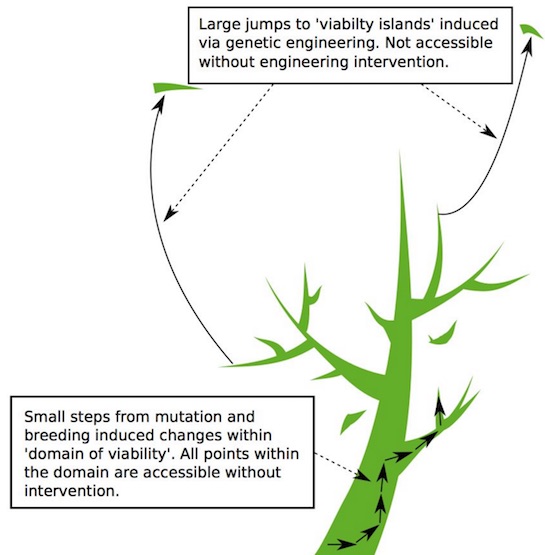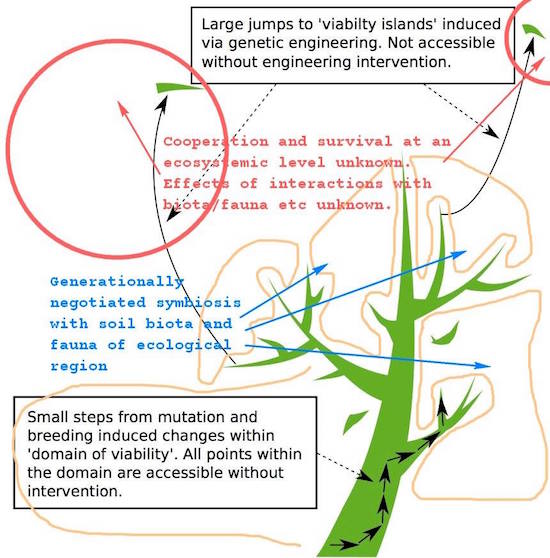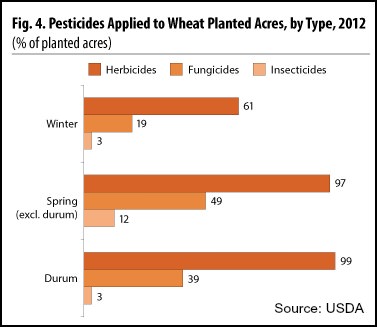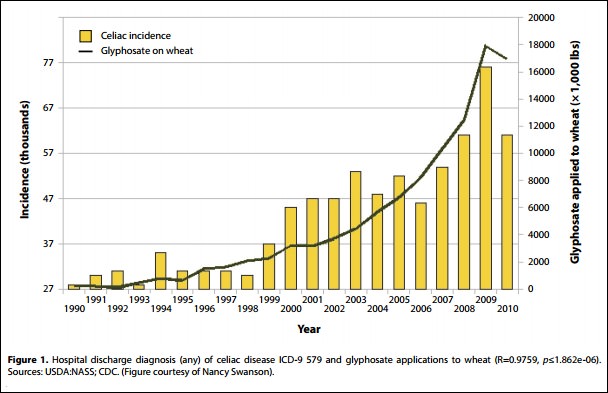Toxic Wheat, GMO's and the Precautionary Principle
by The Automatic Earth
July 17, 2016
Recently, I posted a two-tear old article on facebook.com/TheAutomaticEarth that was shared so many times it seems to make sense to use it for an Automatic Earth article as well.
The article asks how toxic the wheat we eat is – or Americans, more specifically-, and why that is.
But first I would like to touch on a closely connected issue, which is Nassim Nicholas Taleb’s ‘war’ on GMOs. Taleb, of Black Swans fame, has been at it for a while, but he’s stepped up his efforts off late.
In 2014, with co-authors Rupert Read, Raphael Douady, Joseph Norman and Yaneer Bar-Yam, he published The Precautionary Principle (with Application to the Genetic Modification of Organisms), an attempt to look at GMOs through a ‘solidly scientific’ prism of probability and complex systems. From the abstract:
The precautionary principle (PP) states that if an action or policy has a suspected risk of causing severe harm to the public domain (affecting general health or the environment globally), the action should not be taken in the absence of scientific near-certainty about its safety. Under these conditions, the burden of proof about absence of harm falls on those proposing an action, not those opposing it. PP is intended to deal with uncertainty and risk in cases where the absence of evidence and the incompleteness of scientific knowledge carries profound implications and in the presence of risks of “black swans”, unforeseen and unforeseable events of extreme consequence.
[..] We believe that the PP should be evoked only in extreme situations: when the potential harm is systemic (rather than localized) and the consequences can involve total irreversible ruin, such as the extinction of human beings or all life on the planet. The aim of this paper is to place the concept of precaution within a formal statistical and risk-analysis structure, grounding it in probability theory and the properties of complex systems. Our aim is to allow decision makers to discern which circumstances require the use of the PP and in which cases evoking the PP is inappropriate.
This puts into perspective the claims made by Monsanto et al that since no harm has ever been proven to arise from the use of GMOs, they should therefore be considered safe. Which is the approach largely taken over by American politics, and increasingly also in Europe and other parts of the world. In their paper, Taleb et al say the approach does not meet proper scientific standards.
This is very close to my personal opinion, expressed in many articles in the past, that GMOs pose such risks on such a wide scale to the food supply of every human being on earth -as well as a much wider selection of organisms- that they should not be legalized before perhaps 100 years of tests have been done by large and independent teams of specialists.
Note that if you, as an individual farmer, as a community or even as a nation, want to ban GMOs but your neighbors do not, you will in the case of many crops not stand a chance of keeping your plants GMO free. For which you can subsequently be sued by the ‘owner’ of the genetically altered plants and seeds.
Also, I think it is irresponsibly dangerous to give a handful of companies (Monsanto, Bayer, DuPont, Syngenta), who all happen to be chemical giants dating back to the 20th century interbellum, and all with questionable pasts, a quasi-monopoly over the -future of- world’s food. Because that is where things will go unless proper principles are applied, both scientific and legal.
One of the main arguments proponents of GMOs use is that through thousand of years mankind has altered crops through selection ‘anyway’, so talking about anything ‘pure’ or ‘natural’ in this regard is not relevant. Taleb put the difference between altering a staple through this ‘generational’ selection on the one hand and the modifying of genes in a lab into a sketch:

The sketch was later annotated by Rahul Goswami, approved and shared by Taleb:

I think it is obvious that ‘generational’ selection through breeding is localized, can be rejected by nature. Genetic modification is something completely different, it takes a much bigger step (a giant leap) and forces itself -as a more or less alien body- onto a much larger eco-system.
It’s not about trying to figure out what works, but about forcing itself upon the world and its inhabitants regardless of the consequences. The precautionary principle is missing where it is most needed.
A few examples of Taleb’s tweets on the topic in the past few days make his stance abundantly clear.
“GMO issue is ignorance of the properties of complex systems/fattails (Monsanto’s 107 Nobels, 80 y.o. are 50 y behind)”
“Anyone pro-GMOs on “scientific” grounds is 50 years behind, ignorant of complexity, or just stupid”
“Monsanto pulled no stop trying to discredit me: 1000 mails to Univ (!),>1000 shill posts. Nada. F***you money works.”
Then, on to the article I started talking about above. As I said, it was written some two years ago by Sarah at the Healthy Home Economist. From the reactions to my posting it on Facebook -a huge number of shares- I surmise that many people A) had no idea that what Sarah describes is common practice, and B) have a profound interest in the topic.
Note: while a fair number of people said they had never heard of this, and/or doubted it was true at all, quite a few confirmed it as common where they live, and not just stateside, but in Scotland, Argentina etc.
Let’s see how we get through this. I don’t want to just post the whole thing, but I’ll need large portions of it.
The Real Reason Wheat is Toxic
The stories became far too frequent to ignore. Emails from folks with allergic or digestive issues to wheat in the United States experienced no symptoms whatsoever when they tried eating pasta on vacation in Italy. Confused parents wondering why wheat consumption sometimes triggered autoimmune reactions in their children but not at other times.
In my own home, I’ve long pondered why my husband can eat the wheat I prepare at home, but he experiences negative digestive effects eating even a single roll in a restaurant. There is clearly something going on with wheat that is not well known by the general public. It goes far and beyond organic versus nonorganic, gluten or hybridization because even conventional wheat triggers no symptoms for some who eat wheat in other parts of the world.
What indeed is going on with wheat? For quite some time, I secretly harbored the notion that wheat in the United States must, in fact, be genetically modified. GMO wheat secretly invading the North American food supply seemed the only thing that made sense and could account for the varied experiences I was hearing about. I reasoned that it couldn’t be the gluten or wheat hybridization. Gluten and wheat hybrids have been consumed for thousands of years.
It just didn’t make sense that this could be the reason for so many people suddenly having problems with wheat and gluten in general in the past 5-10 years.
Finally, the answer came over dinner a couple of months ago with a friend who was well versed in the wheat production process. I started researching the issue for myself, and was, quite frankly, horrified at what I discovered. The good news is that the reason wheat has become so toxic in the United States is not because it is secretly GMO as I had feared (thank goodness!).
The bad news is that the problem lies with the manner in which wheat is grown and harvested by conventional wheat farmers. You’re going to want to sit down for this one. I’ve had some folks burst into tears in horror when I passed along this information before.
Common wheat harvest protocol in the United States is to drench the wheat fields with Roundup several days before the combine harvesters work through the fields as the practice allows for an earlier, easier and bigger harvest
Pre-harvest application of the herbicide Roundup or other herbicides containing the deadly active ingredient glyphosate to wheat and barley as a desiccant was suggested as early as 1980. It has since become routine over the past 15 years and is used as a drying agent 7-10 days before harvest within the conventional farming community.USDA pesticides applied to wheat.
According to Dr. Stephanie Seneff of MIT who has studied the issue in depth and who I recently saw present on the subject at a nutritional Conference in Indianapolis, desiccating non-organic wheat crops with glyphosate just before harvest came into vogue late in the 1990’s with the result that most of the non-organic wheat in the United States is now contaminated with it.
Seneff explains that when you expose wheat to a toxic chemical like glyphosate, it actually releases more seeds resulting in a slightly greater yield: “It ‘goes to seed’ as it dies. At its last gasp, it releases the seed” says Dr. Seneff. According to the US Department of Agriculture, as of 2012, 99% of durum wheat, 97% of spring wheat, and 61% of winter wheat has been treated with herbicides. This is an increase from 88% for durum wheat, 91% for spring wheat and 47% for winter wheat since 1998.

Wheat farmer Keith Lewis: “I have been a wheat farmer for 50 yrs and one wheat production practice that is very common is applying the herbicide Roundup (glyphosate) just prior to harvest. Roundup is licensed for preharvest weed control. Monsanto, the manufacturer of Roundup claims that application to plants at over 30% kernel moisture result in roundup uptake by the plant into the kernels. Farmers like this practice because Roundup kills the wheat plant allowing an earlier harvest.
A wheat field often ripens unevenly, thus applying Roundup preharvest evens up the greener parts of the field with the more mature. The result is on the less mature areas Roundup is translocated into the kernels and eventually harvested as such. This practice is not licensed. Farmers mistakenly call it “dessication.”
Consumers eating products made from wheat flour are undoubtedly consuming minute amounts of Roundup. An interesting aside, malt barley which is made into beer is not acceptable in the marketplace if it has been sprayed with preharvest Roundup. Lentils and peas are not accepted in the market place if it was sprayed with preharvest roundup….. but wheat is ok.. This farming practice greatly concerns me and it should further concern consumers of wheat products.”
This practice is not just widespread in the United States either. The Food Standards Agency in the United Kingdom reports that use of Roundup as a wheat desiccant results in glyphosate residues regularly showing up in bread samples. Other European countries are waking up to to the danger, however. In the Netherlands, use of Roundup is completely banned with France likely soon to follow.
Using Roundup on wheat crops throughout the entire growing season and even as a desiccant just prior to harvest may save the farmer money and increase profits, but it is devastating to the health of the consumer who ultimately consumes the glyphosate residue laden wheat kernels.
The chart below of skyrocketing applications of glyphosate to US wheat crops since 1990 and the incidence of celiac disease is from a December 2013 study published in the Journal Interdisciplinary Toxicology examining glyphosate pathways to autoimmune disease. Remember that wheat is not currently GMO or “Roundup Ready” meaning it is not resistant to its withering effects like GMO corn or GMO soy, so application of glyphosate to wheat would actually kill it.

While the herbicide industry maintains that glyphosate is minimally toxic to humans, research published in the Journal Entropy strongly argues otherwise by shedding light on exactly how glyphosate disrupts mammalian physiology. Authored by Anthony Samsel and Stephanie Seneff of MIT, the paper investigates glyphosate’s inhibition of cytochrome P450 (CYP) enzymes, an overlooked component of lethal toxicity to mammals.
The currently accepted view is that glyphosate is not harmful to humans or any mammals. This flawed view is so pervasive in the conventional farming community that Roundup salesmen have been known to foolishly drink it during presentations! However, just because Roundup doesn’t kill you immediately doesn’t make it nontoxic. In fact, the active ingredient in Roundup lethally disrupts the all important shikimate pathway found in beneficial gut microbes which is responsible for synthesis of critical amino acids.
Friendly gut bacteria, also called probiotics, play a critical role in human health. Gut bacteria aid digestion, prevent permeability of the gastrointestinal tract (which discourages the development of autoimmune disease), synthesize vitamins and provide the foundation for robust immunity. In essence:
Roundup significantly disrupts the functioning of beneficial bacteria in the gut and contributes to permeability of the intestinal wall and consequent expression of autoimmune disease symptoms
In synergy with disruption of the biosynthesis of important amino acids via the shikimate pathway, glyphosate inhibits the cytochrome P450 (CYP) enzymes produced by the gut microbiome. CYP enzymes are critical to human biology because they detoxify the multitude of foreign chemical compounds, xenobiotics, that we are exposed to in our modern environment today.
As a result, humans exposed to glyphosate through use of Roundup in their community or through ingestion of its residues on industrialized food products become even more vulnerable to the damaging effects of other chemicals and environmental toxins they encounter! What’s worse is that the negative impact of glyphosate exposure is slow and insidious over months and years as inflammation gradually gains a foothold in the cellular systems of the body.
The consequences of this systemic inflammation are most of the diseases and conditions associated with the Western lifestyle: Gastrointestinal disorders, Obesity ,Diabetes, Heart Disease, Depression, Autism, Infertility, Cancer, Multiple Sclerosis, Alzheimer’s, etc.
In a nutshell, Dr. Seneff’s study of Roundup’s ghastly glyphosate which the wheat crop in the United States is doused with uncovers the manner in which this lethal toxin harms the human body by decimating beneficial gut microbes with the tragic end result of disease, degeneration, and widespread suffering
[..] The bottom line is that avoidance of conventional wheat in the United States is absolutely imperative even if you don’t currently have a gluten allergy or wheat sensitivity. The increase in the amount of glyphosate applied to wheat closely correlates with the rise of celiac disease and gluten intolerance.
Dr. Seneff points out that the increases in these diseases are not just genetic in nature, but also have an environmental cause as not all patient symptoms are alleviated by eliminating gluten from the diet. The effects of deadly glyphosate on your biology are so insidious that lack of symptoms today means literally nothing. If you don’t have problems with wheat now, you will in the future if you keep eating conventionally produced, toxic wheat!
I guess we can leave it at that for now. Do go to the original article for more. Whether you look at it from a scientific viewpoint, as Taleb et al do, or from a common sense one, as Sarah does, the common thread seems obvious: Monsanto and other rich chemical giants seek to be the sole providers -even owners- of the world’s food, handed to us for free by nature and generations of our ancestors.
And to achieve that magnitude of power -and riches- they are more than willing to literally drive over sick and dead bodies. Once again, Taleb:
The precautionary principle (PP) states that if an action or policy has a suspected risk of causing severe harm to the public domain (affecting general health or the environment globally), the action should not be taken in the absence of scientific near-certainty about its safety. Under these conditions, the burden of proof about absence of harm falls on those proposing an action, not those opposing it.
That is not what’s happening, and there’s not much time left to start applying it before it’s too late. Because GMOs, once they’ve been introduced in a large enough environment, are near impossible to get rid of.
To end on a somewhat happier note, Taleb thinks that Monsanto is doing quite poorly these days, financially. Then again, that’s why Bayer wants to buy them, and that would only mean a continuation or even increase of the present practices.
What we need is decision makers who understand the science of complex systems, probability and the precautionary principle. And I don’t know about you, but when I look at who’s vying to be the leaders of the US, UK and many other nations, I think we’re a long way away from that.
Only Putin seems to get it. His stated goal is to make Russia the largest producer of organic food in the world. So maybe there is still hope.

No comments:
Post a Comment